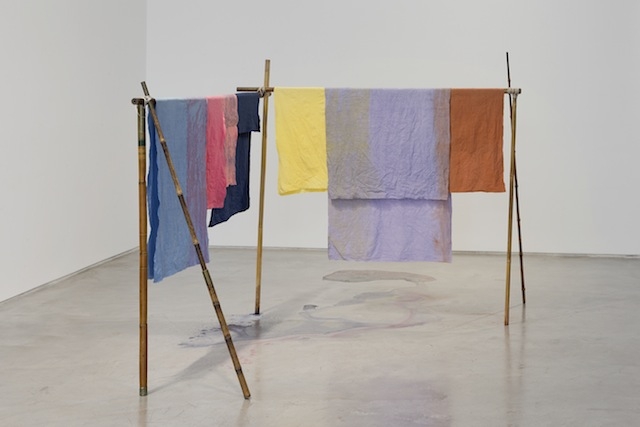Galerie Art: Concept, Paris, 8 April – 13 May
Depending on whether you take Ulla von Brandenburg’s fourth solo show at Art: Concept at face value or pursue its subtext, you may be bored or scared to death. With deliquescing colours and missing bodies, the German-born, Paris-based artist (and 2016 Prix Marcel Duchamp nominee) has here staged a spooky spectacle for whoever is clairvoyant enough to interpret it as such. Directly upon entering, Falten & Körper, Zweige (Plis & Corps, Branches), Falten & Körper, Kiste, Nägel (Plis & Corps, Boite, Clous) and Falten & Körper, Fisch (Plis & Corps, Poisson) (all works 2017) summon the spirit of Yves Klein. These three chlorine ‘anthropometries’, loosely hanging against the walls, were realised by spraying bleach on moving performers draped in ultramarine sheets. Once unfolded, these unpredictable theatrical abstractions, comparable in process to photograms, read somewhere in between the Turin Shroud – an alleged image of Jesus on what is believed to be his burial cloth – and the carbon-frozen Han Solo in The Empire Strikes Back (1980). Although nobody was harmed in the making, the only visible trace of the performers’ bodies is a series of clenched fists on the gloomily and unevenly discoloured resulting curtains. Wait for these phantoms to blow via the slightest draught inside the gallery and you’re in for a serious chill.
Proceedings continue with Norma, Jacqueline, Nacht and Lyda, four watercolours on gesso and wood, which portray performing artists, presumably actors or dancers. The protagonists’ ghostly, plain white faces and bodies are left unpainted, whereas the figures are each outlined with an ethereal, eerie rainbow of dripping colours. The final paintings not only look haunted, but also as if pigmented tears were seeping through them. Not a crime scene but a scene of, well, dyeing can be further witnessed under the sculpture Two Times Seven, made in situ. It consists of seven pieces of cloth tinted in the gallery before being hung up to dry on an assemblage of seven fishing rods. Whereas the buckets in which the artist sank her fabrics were removed from the final work, forensic investigators won’t need luminol here: the dyes dribbling from the wet textiles left stains all over the floor, which struck me at first as colourful evidence of a pictorial slaughter.
Finally, the ten-minute film C, Ü, I, T, H, E, A, K, O, G, N, B, D, F, R, M, P, L completes the ensemble with an uncanny procession of floating unworn skirts, which languidly come at the viewers, each in turn filling the entire frame without ever revealing any sort of background besides another plain or patterned textile right behind it. This strange cortege is accompanied by an otherworldly chorus, the lyrics of which, like the title, are supposedly reduced to the letters comprising the last verse, in German translation, of Wisława Szymborska’s 1962 poem ‘Rozmowa z kamieniem’: ‘Ich klopfe an die Tür des Steins. “Ich bin’s, mach auf.” “Ich hab keine Tür”, sagt der Stein’ (‘I knock at the stone’s front door. “It’s only me, let me come in.” “I don’t have a door,” says the stone’). Yet, after careful verification, the ‘s’ is missing here, just like the entire exhibition is lacking bodies, and the stone a door. Hoping to solve this ultimate mystery – for it felt like a matter of life and death to figure out whether or not this was voluntary – I was informed (by the artist) that this was in fact a simple lapse. No matter what, my subsequent frustration, like von Brandenburg’s film and Szymborska’s poem, symbolises the forever-unquenched thirst for knowledge.
It has been commonly stated that von Brandenburg uses fabrics, one of the most recurring materials in her work, to mark the threshold between reality and artifice, as theatrical curtains and costumes do. I believe she uses them to breathe life into her aesthetics all the more interestingly when performers are actually missing. After all, if the main point of this exhibition isn’t that it is totally haunted, what thrill are we left with? Do the skirts come with clothes hangers too?
First published in the Summer 2017 issue of ArtReview
